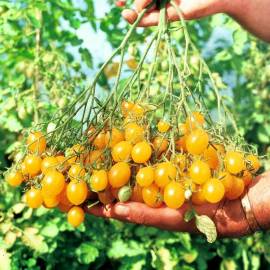


«Kalebasa» - Organic Calabash Seeds
1.14 €
An original, high-yielding, exotic plant - young ovaries are eaten: they are stewed, fried, pickled, dishes are made from ripened and matured fruits or used to decorate the interior.
-
Heirloom Calabash «Kalebasa»
This is an original exotic annual plant of the pumpkin family, a species of the genus Lagenaria. Care is the same as for all pumpkin seeds. Homeland is considered Africa, the territory of modern Zimbabwe. From where it spread through Central Asia to China. With its watertightness, solid wall and buoyancy, the fruits of sea currents also reached the American continents.
In the culture of the people of Lagenaria, ordinary was used as dishes even before the use of pottery and was found in excavations dating back to 4000 BC.
Cultivated for the fruits that are used for a variety of purposes. Young fruits are used for food, especially in long-fruited forms, mature fruits of bottle-shaped fruits are used most often as vessels, as well as in the manufacture of phallocrypts and musical instruments.
The stem growth rate is 20-25 cm per day. The period from germination to fruiting is 150 days.
The flowers are large, white, tubular, dioecious, and have an unpleasant odor. They are located singly in the leaf axils. They open at night, close after 8-20 hours. Pollination occurs by hawk moths: (Latin Hippotion celerio) and (Latin Gorgyra johnstoni).
Fruits, depending on the subspecies and varieties, are from 30 cm to 2.2 m long, weighing up to 32 kg (the record is 150 kg). The number of fruits from one plant to 10. The shape is different: flattened, spherical, pear-shaped, cylindrical, bottle-shaped, serpentine. When cutting off a part of the growing fruit from the side of the end, it heals and grows further.
At biological maturity, the bark of the fruit becomes firm, woody, waterproof, the pulp dries up. The thickness of the fruit bark in vegetable cylindrical forms is 4-5 mm, in decorative bottle forms it reaches 15 mm. The growth of fruits in cylindrical forms is up to 10 cm per day in length, while growth continues even when part of the fruit is cut off, the cut site is healed. The leaves are pentagonal, corrugated.
High-yielding, up to 40 kg of fruits per plant. Young ovaries are eaten: they are stewed, fried, pickled. From ripened and matured fruits, they make dishes or use them to decorate the interior.
Lagenaria plants can be used to decorate walls, gazebos, large bright leaves and white flowers are very effective.
The name can be pronounced as kalєbasa, oscilassa, kolebassa, kalebasa.
Products Viewed Before
Product code: 5372
1.14 €
Really productive producer of huge yellow to red fruit, that taste like fruit, so sweet, very delicious, refreshing mixture of tangy and sweet, mouthwatering with no acid after bite, very good eaten by itself, not even a bit of salt, great for slicing.
Product code: 10345
1.14 €
Ildi is often sold commercially in farmer's markets as Yellow Grape, these yummy tomatoes usually produce till frost, a great cherry tomato choice for serving in salads or snacking off the vine, like eating candy.


